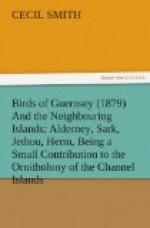Professor Ansted does not include the Little Gull in his list, and there is no specimen in the Museum.
173. GREAT SHEARWATER. Puffinus major, Faber. French, “Puffin majeur."[38]—I think I may fairly include the Great Shearwater in my list as an occasional wanderer to the Islands, as, although I have not a Channel Island specimen, nor have I seen it near the shore or in any of the bays, I did see a small flock of four or five of these birds in July, 1866, when crossing from Guernsey to Torquay. We were certainly more than the Admiralty three miles from the land; but had scarcely lost sight of Guernsey, and were well within sight of the Caskets, when we fell in with the Shearwaters. They accompanied the steamer for some little way, at times flying close up, and I had an excellent opportunity of watching them both with and without my glass, and have therefore no doubt of the species. There was a heavyish sea at the time, and the Shearwaters were generally flying under the lee of the waves, just rising sufficiently to avoid the crest of the wave when it broke. They flew with the greatest possible ease, and seemed as if no sea or gale of wind would hurt them; they never got touched by the breaking sea, but just as it appeared curling over them they rose out of danger and skimmed over the crest; they never whilst I was watching them actually settled on the water, though now and then they dropped their legs just touching the water with their feet.
The Great Shearwater is not mentioned in Professor Ansted’s list, and there is no specimen in the Museum.
174. MANX SHEARWATER. Puffinus anglorum, Temminck. French, “Petrel Manks.”—The Manx Shearwater can only be considered as an occasional wanderer to the Channel Islands, and never by any means so common as it is sometimes on the opposite side of the Channel about Torbay, especially in the early autumn. I have one Guernsey specimen, however, killed near St. Samson’s on the 28th September, 1876.[39] As far as I can make out the Manx Shearwater does not breed in any part of the Channel Islands, but being rather of nocturnal habits at its breeding-stations, and remaining in the holes and under the rocks where its eggs are during the day, it may not have been seen during the breeding-season; but did it breed anywhere in the Islands more birds, both old and young, would be seen about in the early autumn when the young first begin to leave their nests; and the Barbelotters would occasionally come across eggs and young birds when digging for Puffins’ eggs.
The Manx Shearwater is not included in Professor Ansted’s list, and there is no specimen in the Museum.




